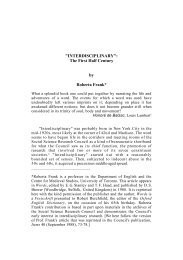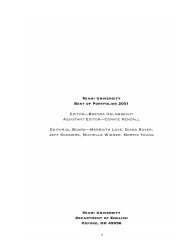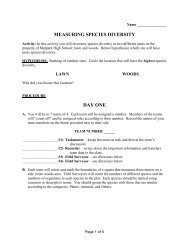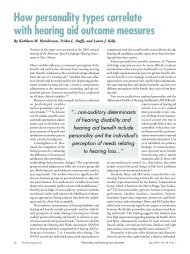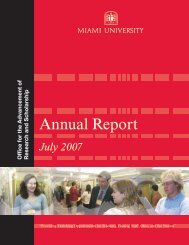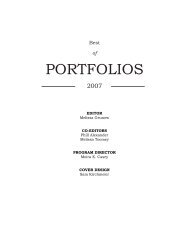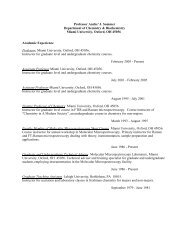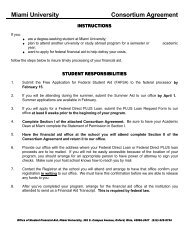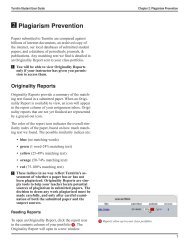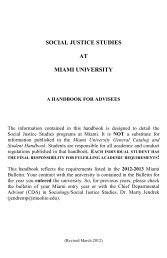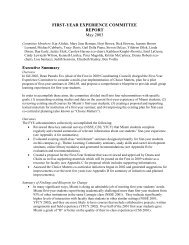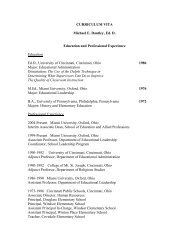Interdisciplinary Research Manual - Units.muohio.edu
Interdisciplinary Research Manual - Units.muohio.edu
Interdisciplinary Research Manual - Units.muohio.edu
You also want an ePaper? Increase the reach of your titles
YUMPU automatically turns print PDFs into web optimized ePapers that Google loves.
47<br />
earlier chapters. Thus, if not fully integrating as one goes, one can at least lay the<br />
groundwork for future integration.<br />
But how do you go back and forth between general and specific, theory and<br />
application, abstract and concrete, text and context without losing coherence? How do<br />
you avoid putting one perspective ahead of another, and thus privileging it (if in no other<br />
way via the primacy and recency effects)? You can end up deciding that some disciplines<br />
will contribute more to the project than others, but that should be only after they’ve all<br />
received a fair hearing. Presenting one after another without regard for the psychological<br />
effects of the order in which they are presented does not give them all a fair hearing.<br />
Unfortunately, the linear format of the physical senior project itself (in which pages are<br />
numbered and read sequentially, so that page 2 follows page 1 and readers normally start<br />
at the beginning and read towards the end) doesn’t fit the logic of interdisciplinary<br />
exposition. One might be tempted to think about structures like choose-your-ownadventure<br />
or hypertext, but those are a cop out: they say, I won’t impose priorities and<br />
values on these disciplines, but I’ll let you do it; yet no one should be doing that. As<br />
pointed out earlier, it helps to set out in the introduction what structure you’re using and<br />
how it relates to the interdisciplinary process. After all, the very fact that you’re writing<br />
an interdisciplinary project means that you’re not fulfilling conventional expectations of<br />
the reader (which are based on a single-perspective approach to a topic). Since you’re<br />
rejecting that approach, it’s incumbent upon you to explain what approach you are taking.<br />
Moreover, unlike disciplinary papers where readers are already interested in the<br />
perspective, readers of interdisciplinary papers have to be sold on the utility, even the<br />
legitimacy, of the other contributing perspectives. Readers from contributing disciplines<br />
have rather focused interests, and you’re asking them to become interested in what you<br />
say about some larger, more comprehensive issue. Their first response is likely to be,<br />
“Why should I care?” One way to do that is to draw readers into that larger issue by<br />
helping them visualize themselves in that situation in that time and place by letting them<br />
experience it vicariously through your experiences, which you can appropriate narrate in<br />
the first person singular, or the experiences of others. Every author has the challenge of<br />
drawing in readers, but interdisciplinary authors have a special challenge because of the<br />
way interests get structured in the academy. Techniques such as the use of personal<br />
examples that draw the reader into a perspective are a plus in disciplinary writing; they<br />
become essential in an interdisciplinary context. The interdisciplinary writer is presenting<br />
an unfamiliar way of thinking as well as a substantive argument, so techniques such as<br />
asking questions help to engage readers in the process instead of merely presenting the<br />
results of that process. Questions can draw the disciplinary reader not only emotionally<br />
into the issues related to the topic (into the process of thinking about the topic), but also<br />
intellectually into the interdisciplinary process. Questions at the end of a later chapter<br />
need not be different than those in earlier chapters, so much as further along the thinking<br />
process. Questions based on personal experience can also serve as a touchstone to which<br />
you keep returning in order to ground abstract or complicated ideas in the reality of lived<br />
experience.<br />
When you read a work of non-fiction, the author has a thesis or position and the<br />
entire book lays out a line of argument or case in support of that position. But that author<br />
did not start out the research process with that line of argument all worked out. The<br />
intellectual route the author took was probably quite circuitous. But when authors



